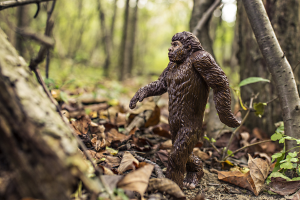 The Paleo Diet has been a hot topic that carries a simple and fascinating premise: the best thing for us to eat is what our ancient ancestors ate as they evolved to become the human beings we are today. Dr. Christina Warinner is an expert on ancient diets. She obtained her Ph.D. from Harvard University in 2010, specializing in ancient DNA analysis and paleodietary reconstruction. She knows a lot about what our ancient human ancestors ate. So how much of the diet fad the “Paleo Diet” is based on an actual Paleolithic diet? Her research indicates the answer is: not much.
The Paleo Diet has been a hot topic that carries a simple and fascinating premise: the best thing for us to eat is what our ancient ancestors ate as they evolved to become the human beings we are today. Dr. Christina Warinner is an expert on ancient diets. She obtained her Ph.D. from Harvard University in 2010, specializing in ancient DNA analysis and paleodietary reconstruction. She knows a lot about what our ancient human ancestors ate. So how much of the diet fad the “Paleo Diet” is based on an actual Paleolithic diet? Her research indicates the answer is: not much.
Dr. Warinner has excavated around the world, from the Maya jungles of Belize to the Himalayan mountains of Nepal, and she is pioneering the biomolecular investigation of archaeological dental calculus (tartar) to study long-term trends in human health and diet. She is a 2012 TED Fellow, and her work has been featured in Wired UK, the Observer, CNN.com, Der Freitag, and Sveriges TV. She obtained her Ph.D. from Harvard University in 2010, specializing in ancient DNA analysis and paleodietary reconstruction.
The currently popular Paleo Diet has it’s roots in the 1970’s as the Stone Age Diet. Since then several variants have been spawned including the Primal Blueprint, the New Evolution Diet and NeanderThin. Marketing is targeted mainly at men, with cave-man images and calls for living a “primal” lifestyle.
The ideas behind the diet can be broken down into 4 parts:
1. Our modern day agricultural diets make us chronically ill and are out of sync with our biology
2. We need to abandon our modern agricultural diets and eat more like our ancestors did 10,000 years ago during the paleolithic period
3. We know what these diets were like, and they were mainly meat based supplemented by fruits and vegetables but definitely did not contain grains, legumes or dairy
4. If we emulate this ancient diet that it will improve our health and help us live longer.
The problem is that according to Dr. Warinner, this Madison Avenue version of the ancient Paleo diet that is promoted on T.V. and in the press, in self-help books and websites, has no basis in archaeological reality. The evidence points to a completely different set of facts. She contends that while some Paleolithic ancestors in certain climates may have eaten significant quantities of meat due to climate or lack of biodiversity, for the most part we are functionally designed to eat mostly plants. Additionally, the historic record proves that many of the common foods available to us in our modern diet are to a large extent quite different, and some didn’t even exist, compared to what would have been available to our Paleolithic ancestors due to modern farming and agricultural processes. Dr. Warriner covers this intriguing subject in a great TEDx Talk. The conclusion of which she boils down to three unsurprising yet key lessons that we should learn from the real Paleo diet:
1. There is no one correct diet. Dietary diversity is key. Including mostly plants and some meat.
2. We need to eat fresh seasonal food vs. processed foods whenever possible.
3. We need to eat whole foods when possible, including grains and legumes.
Author: Larry Goss
-
Harvard Researcher Challenges the Paleo Diet
-
Feeling “Burned-Out”? Here’s help from a survivor.
 Burn-out is the mortal enemy of Vitality. If you’re suffering from burn-out, your life is out of balance by definition. Burn-out is much more than a cliché’, or something to take foolish pride in which demonstrates your commitment, dedication and persistence to a cause. It’s a state of physical, psychological and mental exhaustion, and a warning signal of lifestyle choices that need attention immediately. Your health, along with your relationships and psychological well being, are threatened. It may seem like burn-out “just happens” to us, but the reality is that it comes from a combination of factors and environmental conditions, each of which is unique to our own situation, which creates a potent brew. The good news is that we can change this trajectory. There are things that we can do to combat burn-out and get our lives back into balance.
Burn-out is the mortal enemy of Vitality. If you’re suffering from burn-out, your life is out of balance by definition. Burn-out is much more than a cliché’, or something to take foolish pride in which demonstrates your commitment, dedication and persistence to a cause. It’s a state of physical, psychological and mental exhaustion, and a warning signal of lifestyle choices that need attention immediately. Your health, along with your relationships and psychological well being, are threatened. It may seem like burn-out “just happens” to us, but the reality is that it comes from a combination of factors and environmental conditions, each of which is unique to our own situation, which creates a potent brew. The good news is that we can change this trajectory. There are things that we can do to combat burn-out and get our lives back into balance.Tchiki Davis, M.A.,Ph.D, is a University of Berkeley graduate and expert on well-being technology and self-described burn-out “survivor”. She’s reflected and written about her own personal experience of burn-out as a Ph.D. student at Berkeley. Like many who find themselves burned-out, her reasons for this condition were not fully apparent as they were occurring, she was just really, really busy achieving her goals. In her case, she was not only writing her Doctoral dissertation, she was also getting another advanced degree in a different field, and fund raising for her new start-up business all at the same time. Here are some of the signals and lessons she’s learned about how to spot the path to burn-out and some suggestions on what to do about it:
- Your personality may be a risk factor: You see yourself as highly motivated and persistent. You take great pride in showing off your dedicated work ethic to your co-workers and superiors. You “live to work”, working long hours and regularly miss out on non-work time with family and friends. If this is you, you may be at risk of burn-out.
- What to do: Apply your hyper-focused planning skills to your own life and schedule in some recurring non-work time with friends and family to help achieve better balance.
- Social comparison is a risk factor: If you believe you are surrounded by people who are amazing at the same thing you’re supposedly amazing at, you’re likely doing an internal comparison and working harder and harder to demonstrate your own mastery.
- What to do: If you can work in an environment where everyone has mastery of different skills, or more defined responsibilities, you will be less likely to fall into this comparison trap.
- Local culture can be a risk factor: If you find yourself in a local culture, such as a business or university, where everyone is expected to be, or known to be, a star you’re at risk of feeling pressure from outside forces that you must work harder and harder to keep up with the pack.
- What to do: Recognize that no one has the right to diminish you or make you feel inferior. We all have certain gifts, knowledge and skills that may be different and better than others. Be aware and acknowledge that everyone can grow and change, and practice self acceptance and self compassion.
- Broader culture can be a risk factor: Davis uses the example of Silicon Valley, home to some of the most successful technology companies and smartest individuals in the world, to demonstrate how an entire community can set the bar of success unreasonably high. It may be inspiring and invigorating, but it may also lead to burn-out if you feel you’re not keeping up.
- What to do: Set boundaries for yourself. Take control of the situation and decide how many hours are acceptable to you in order for you to maintain a work-life balance. Ask yourself where the deal breakers are. Then be assertive about protecting those boundaries.
Dr. Davis also has some advice for reversing burnout, but warns that burn-out doesn’t happen overnight and it isn’t resolved immediately. It may take chunks of time to reset your well being. But the sooner that you acknowledge that you’re heading down this dangerous road, the sooner you can get your life closer to balance.
The original article by Dr. Davis can be found here on LinkedIn.